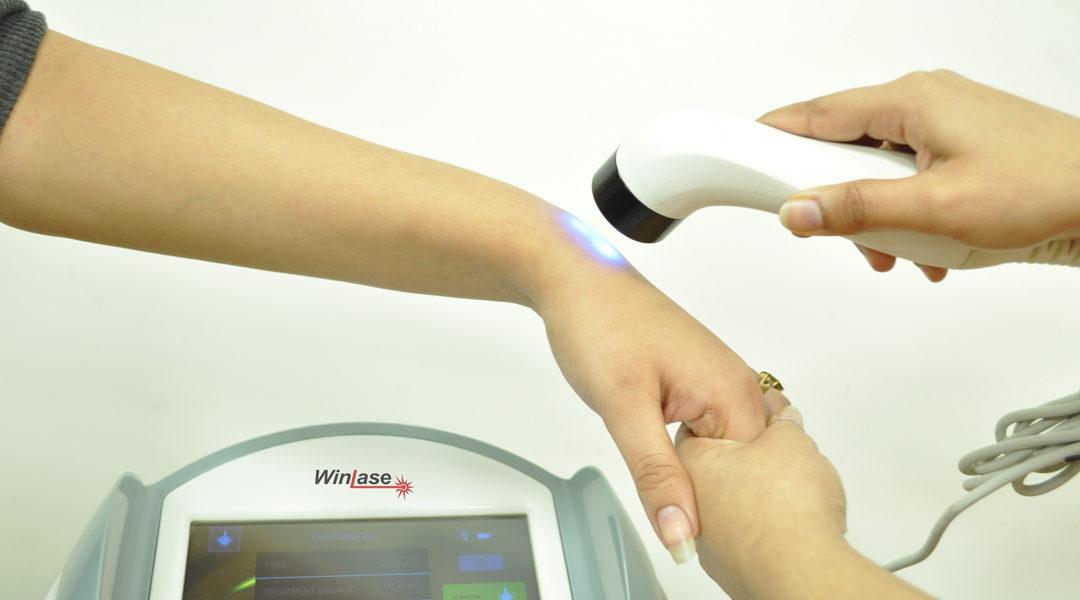Cold laser therapy, also known as low-level laser therapy (LLLT), is an innovative and non-invasive treatment that has gained increasing recognition for its ability to alleviate pain, reduce inflammation, and promote healing. Unlike surgical or high-intensity lasers used in medical procedures, cold lasers do not heat the tissue, making them safe for various conditions. This therapy is particularly beneficial for people who seek an alternative to medications, surgeries, or invasive treatments.
In this blog, we will explore what cold laser therapy is, how it works, its various applications, benefits, and potential side effects, as well as the future outlook for this promising technology.
What is Cold Laser Therapy?
Cold laser therapy involves the use of low-intensity laser light to stimulate healing in the body. The term “cold” refers to the fact that the laser used does not generate heat. The lasers emit light at specific wavelengths, typically in the range of 600 to 1000 nanometers, which can penetrate the skin and interact with tissues at a cellular level.
These wavelengths of light stimulate cellular metabolism, enhance ATP production (the energy currency of cells), and promote cell regeneration and repair. The therapy is painless and generally performed on an outpatient basis. It’s a popular choice for treating musculoskeletal conditions, joint pain, soft tissue injuries, and chronic pain disorders.
How Does Cold Laser Therapy Work?
Cold laser therapy operates on the principle of photobiomodulation. This means that the light emitted by the laser interacts with the body’s cells in a way that promotes healing and reduces pain. Here is a breakdown of how it works:
- Laser Penetration: During the therapy, the laser is applied directly to the affected area. The light penetrates the skin and reaches the damaged or inflamed tissues beneath the surface.
- Cellular Interaction: The light stimulates the mitochondria, the powerhouses of cells, encouraging the production of ATP (adenosine triphosphate). ATP is vital for cellular processes, including repair and regeneration. This boost in ATP production enhances the body’s natural healing process.
- Reduction in Inflammation: Cold laser therapy also triggers a reduction in the levels of pro-inflammatory substances in the body, such as prostaglandins and cytokines. At the same time, it increases anti-inflammatory agents, helping to relieve pain and swelling.
- Tissue Repair and Regeneration: By promoting collagen production and enhancing the function of fibroblasts (cells that play a role in wound healing), cold laser therapy accelerates the repair of damaged tissues.
- Improved Circulation: The therapy also improves blood circulation in the treated area, delivering more oxygen and nutrients to the tissues. This promotes faster recovery and reduces discomfort.
Applications of Cold Laser Therapy
Cold laser therapy has a wide range of applications, particularly in areas of pain management, injury recovery, and inflammation reduction. Some of the most common conditions treated with this therapy include:
1. Musculoskeletal Pain
Cold laser therapy is highly effective for treating various musculoskeletal conditions, including:
- Arthritis: The therapy is known to reduce pain and inflammation associated with both osteoarthritis and rheumatoid arthritis.
- Back and Neck Pain: It is a popular choice for people suffering from chronic lower back or neck pain, providing relief without the need for drugs or surgery.
- Tendinitis: Cold laser therapy can accelerate healing in conditions such as Achilles tendinitis or tennis elbow, reducing inflammation and allowing for faster recovery.
2. Sports Injuries
Athletes often use cold laser therapy to treat soft tissue injuries, sprains, and strains. It helps reduce swelling and promotes faster healing, allowing them to return to their sports more quickly.
3. Wound Healing
Cold laser therapy is beneficial in the treatment of wounds, particularly those that are slow to heal, such as diabetic ulcers or post-surgical incisions. By enhancing tissue repair and boosting collagen production, cold laser therapy can speed up wound healing and minimize scarring.
4. Nerve Damage and Neuropathic Pain
Cold laser therapy has shown promise in treating nerve-related conditions such as peripheral neuropathy, carpal tunnel syndrome, and sciatica. It helps reduce pain, improve nerve function, and promote healing in damaged nerves.
5. Chronic Pain Conditions
Patients with chronic pain conditions like fibromyalgia, temporomandibular joint (TMJ) disorders, and complex regional pain syndrome (CRPS) have reported significant relief with cold laser therapy.
6. Dermatological Applications
Cold laser therapy can also be used to treat skin conditions such as psoriasis, acne, and eczema by reducing inflammation and promoting healthy cell turnover.
Benefits of Cold Laser Therapy
There are numerous advantages to using cold laser therapy over other treatment modalities. Some of the key benefits include:
1. Non-Invasive
Cold laser therapy is a non-invasive treatment, meaning that it does not require any surgical procedures or incisions. This makes it an attractive option for patients who want to avoid the risks and recovery times associated with invasive treatments.
2. Painless
Patients typically experience no pain or discomfort during the procedure. In fact, most describe the sensation as a warm or gentle tingling feeling. Because it is non-invasive and painless, it is suitable for people of all ages.
3. Drug-Free Treatment
Cold laser therapy does not require the use of medications, making it an appealing option for individuals who want to avoid the side effects and potential dependency issues associated with painkillers or anti-inflammatory drugs.
4. Accelerated Healing
By promoting cellular repair and regeneration, cold laser therapy can speed up the healing process, reducing recovery times for injuries and wounds.
5. Targeted Treatment
The therapy can be applied directly to the affected area, allowing for precise targeting of injured tissues or painful joints.
6. No Downtime
There is no downtime associated with cold laser therapy, meaning that patients can resume their normal activities immediately after the session. This is a key advantage over surgical treatments that may require weeks or even months of recovery.
Potential Side Effects and Risks
While cold laser therapy is generally considered safe, there are a few potential side effects that patients should be aware of:
- Temporary Redness or Swelling: Some patients may experience mild redness or swelling at the treatment site, but this usually subsides quickly.
- Allergic Reactions: In rare cases, individuals with sensitive skin may have an allergic reaction to the gel used during treatment.
- Eye Damage: Direct exposure to the laser can cause damage to the eyes, which is why both the patient and practitioner should wear protective goggles during the procedure.
It’s important to consult with a qualified healthcare provider before beginning treatment to ensure that cold laser therapy is appropriate for your condition.
Cold Laser Therapy in Practice
Cold laser therapy sessions are typically short, lasting between 5 to 15 minutes per area. The number of sessions required will vary depending on the condition being treated and its severity. Some patients may experience immediate relief after just one session, while others may require several sessions to achieve optimal results.
Practitioners who offer cold laser therapy include chiropractors, physical therapists, and sports medicine specialists. The therapy is often used in combination with other treatments such as physical therapy, massage, or exercise programs for a holistic approach to healing.
Conclusion: The Future of Cold Laser Therapy
Cold laser therapy represents a promising advancement in the field of pain management and tissue healing. Its non-invasive nature, combined with its ability to stimulate the body’s natural healing mechanisms, makes it an attractive option for individuals suffering from a variety of conditions. With ongoing research and technological advancements, the applications of cold laser therapy are likely to expand even further in the future.
As more healthcare providers adopt cold laser therapy into their practice, patients can expect to see increased availability of this cutting-edge treatment. Whether you’re an athlete recovering from an injury, someone dealing with chronic pain, or a person looking for alternative solutions to traditional medications, cold laser therapy might be the solution you’ve been searching for.
Always consult with a healthcare provider to determine if cold laser therapy is right for your specific needs, and remember that the path to healing can be a combination of multiple treatments and approaches.




